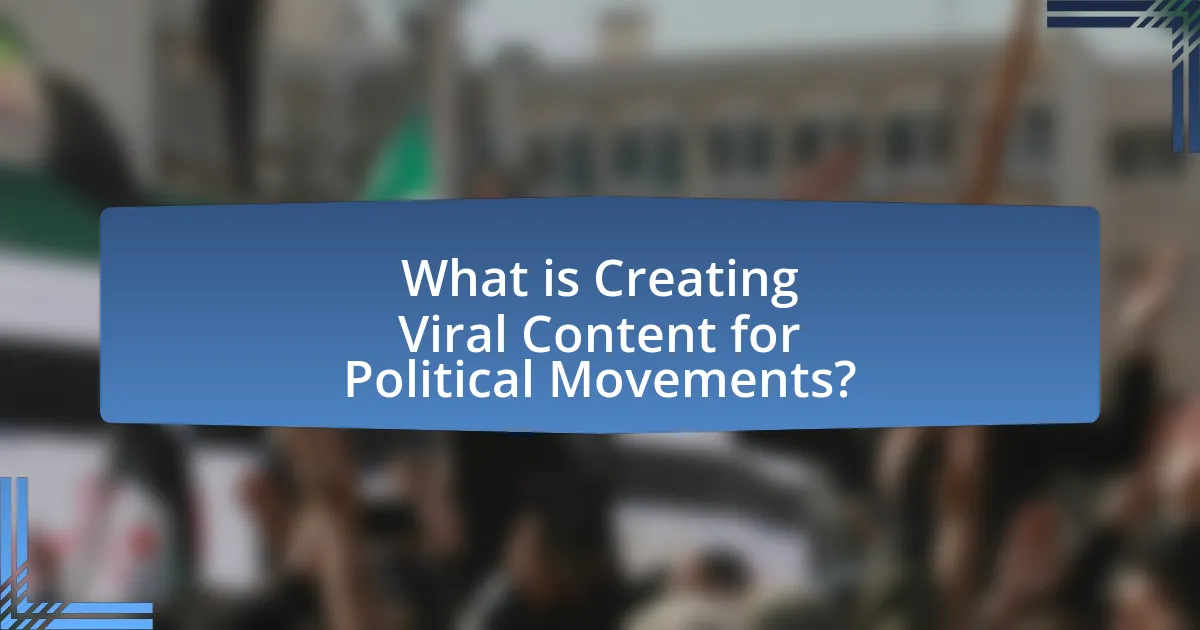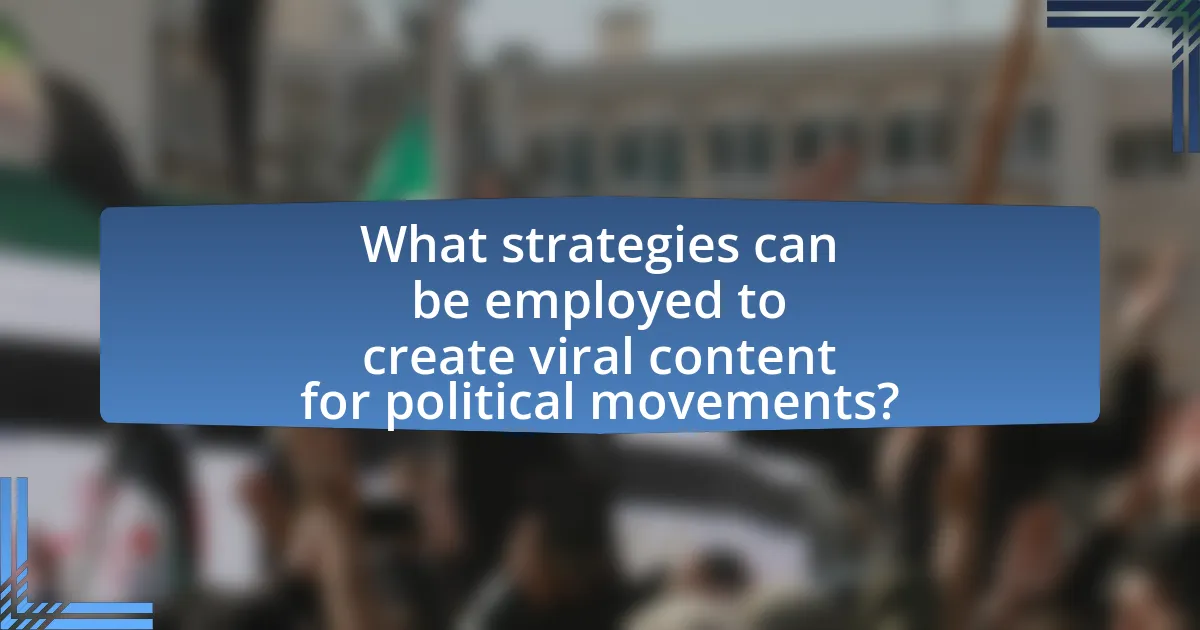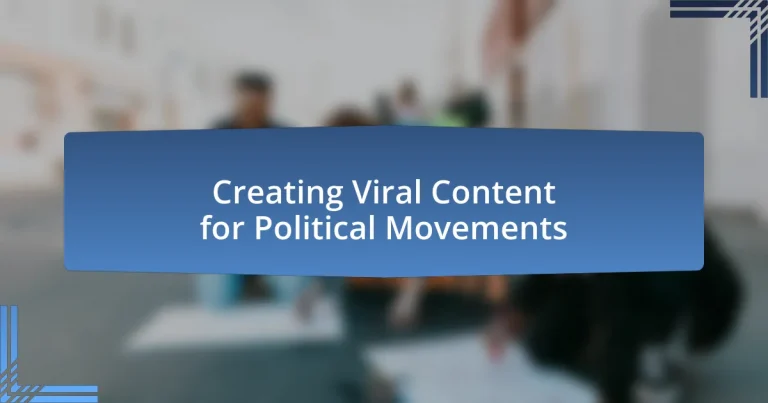Creating viral content for political movements involves producing engaging media that resonates with audiences, driving awareness and action for specific causes. The article explores how viral content influences political movements by rapidly disseminating information and mobilizing support, highlighting key characteristics such as emotional resonance and shareability. It discusses the role of social media in amplifying political messages, strategies for creating effective viral content, and the challenges and risks associated with misinformation and audience fragmentation. Additionally, it emphasizes the importance of ethical considerations and best practices in ensuring that content aligns with political messages while fostering engagement and awareness.

What is Creating Viral Content for Political Movements?
Creating viral content for political movements involves producing engaging and shareable media that resonates with audiences, driving awareness and action for specific causes. This content often leverages emotional appeal, humor, or relatable narratives to capture attention and encourage sharing across social media platforms. For instance, the Ice Bucket Challenge in 2014 raised over $115 million for ALS research by combining a simple challenge with a strong emotional message, demonstrating how effective viral content can mobilize support and funding for political and social issues.
How does viral content influence political movements?
Viral content significantly influences political movements by rapidly disseminating information and mobilizing support. This phenomenon occurs as social media platforms enable messages to reach vast audiences quickly, often leading to increased awareness and engagement in political issues. For instance, the Arab Spring in 2010-2011 showcased how viral videos and social media posts galvanized protests and organized demonstrations across multiple countries, illustrating the power of digital communication in shaping political landscapes. Additionally, studies have shown that viral content can sway public opinion, as seen in the 2016 U.S. presidential election, where memes and shareable posts played a crucial role in influencing voter perceptions and behaviors.
What are the key characteristics of viral content in politics?
Viral content in politics is characterized by emotional resonance, shareability, and relevance to current events. Emotional resonance engages audiences by eliciting strong feelings such as anger, joy, or empathy, which motivates them to share the content. Shareability is enhanced through concise messaging and visually appealing formats, making it easy for users to disseminate across social media platforms. Additionally, relevance to current events ensures that the content aligns with ongoing political discussions, increasing its likelihood of being shared. For instance, during the 2016 U.S. presidential election, memes and videos that captured the emotional stakes of the election went viral, demonstrating these characteristics effectively.
How does audience engagement affect the virality of political content?
Audience engagement significantly enhances the virality of political content by increasing its reach and shareability. When audiences actively interact with political content—through likes, shares, comments, or discussions—they amplify its visibility across social media platforms, leading to a broader dissemination. For instance, a study by the Pew Research Center found that content with higher engagement rates is more likely to be shared, with posts that receive substantial comments or reactions being 10 times more likely to go viral than those with minimal interaction. This engagement not only boosts the content’s algorithmic ranking on platforms but also fosters a sense of community and urgency around political issues, further driving its spread.
Why is creating viral content important for political movements?
Creating viral content is crucial for political movements because it amplifies their message and engages a wider audience. Viral content can rapidly spread across social media platforms, reaching millions of users in a short time, which is essential for mobilizing support and raising awareness about specific issues. For instance, during the Arab Spring, social media campaigns played a pivotal role in organizing protests and disseminating information, demonstrating how viral content can influence political change. Additionally, studies show that emotionally charged content is more likely to be shared, making it a powerful tool for political movements to evoke strong reactions and drive public discourse.
What role does social media play in the dissemination of political content?
Social media serves as a crucial platform for the dissemination of political content by enabling rapid sharing and engagement among users. It allows political messages to reach a vast audience quickly, often leading to viral spread through shares, likes, and comments. For instance, during the 2016 U.S. presidential election, platforms like Twitter and Facebook were instrumental in shaping public discourse, with over 60% of Americans reporting that social media influenced their political views. This influence is further evidenced by the fact that political campaigns increasingly allocate significant portions of their budgets to social media advertising, recognizing its power to mobilize voters and shape narratives.
How can viral content mobilize supporters and increase awareness?
Viral content can mobilize supporters and increase awareness by rapidly spreading messages through social media platforms, engaging users emotionally, and encouraging sharing. When content resonates with audiences, it prompts them to share it within their networks, amplifying its reach. For instance, a study by the Pew Research Center found that 62% of Americans get news from social media, highlighting its role in disseminating information quickly. Additionally, emotionally charged content, such as videos or memes that evoke strong feelings, can lead to higher engagement rates, further driving awareness and support for political movements.

What strategies can be employed to create viral content for political movements?
To create viral content for political movements, employing emotional storytelling, leveraging social media algorithms, and utilizing influencers are effective strategies. Emotional storytelling resonates with audiences, making them more likely to share content; for instance, the “Ice Bucket Challenge” effectively raised awareness for ALS through personal narratives. Leveraging social media algorithms involves creating engaging content that encourages likes, shares, and comments, which increases visibility; platforms like Facebook and Twitter prioritize content that generates interaction. Utilizing influencers can amplify reach, as seen in the 2016 U.S. presidential election, where endorsements from popular figures significantly impacted voter engagement and message dissemination.
What types of content are most likely to go viral in political contexts?
Content that is emotionally charged, humorous, or controversial is most likely to go viral in political contexts. Emotional content, such as personal stories or impactful visuals, resonates deeply with audiences, prompting shares and engagement. For instance, viral videos that highlight social injustices or evoke strong feelings can mobilize support and drive discussions. Humor, particularly in the form of memes or satirical commentary, can simplify complex political issues and make them more relatable, as seen in the widespread sharing of political cartoons during election cycles. Controversial content, which challenges prevailing views or exposes scandals, often sparks debate and encourages sharing, as evidenced by the viral nature of whistleblower revelations or leaked documents. These types of content leverage emotional responses, relatability, and debate to maximize their reach and impact in political discourse.
How do emotional appeals enhance the shareability of political content?
Emotional appeals significantly enhance the shareability of political content by triggering strong feelings that motivate individuals to engage and disseminate the message. Research indicates that content evoking emotions such as anger, joy, or fear is more likely to be shared; for instance, a study published in the journal “Science” found that emotionally charged content is shared 30% more often than neutral content. This heightened engagement occurs because emotional responses create a sense of urgency and personal connection, prompting users to share the content with their networks to express their feelings or provoke discussion.
What formats (videos, memes, articles) are most effective for political virality?
Videos and memes are the most effective formats for political virality. Research indicates that videos, particularly short, engaging clips, capture attention quickly and are easily shareable across social media platforms, leading to higher engagement rates. For instance, a study by the Pew Research Center found that 72% of Americans use social media for news, with video content being the most shared type. Memes, on the other hand, leverage humor and relatability, making complex political messages more digestible and shareable. A study published in the journal “New Media & Society” highlighted that memes can spread political messages rapidly, often reaching a wide audience in a short time frame. Articles, while informative, tend to have lower virality due to their longer format, which requires more time and attention from readers.
How can storytelling be utilized in creating viral political content?
Storytelling can be utilized in creating viral political content by crafting relatable narratives that resonate emotionally with the audience. Effective storytelling humanizes political issues, making them more accessible and engaging, which increases the likelihood of sharing. For instance, the viral success of the “Ice Bucket Challenge” in 2014 demonstrated how personal stories about ALS patients galvanized public support and donations, illustrating the power of narrative in mobilizing action. Additionally, research by the Stanford Graduate School of Business found that stories are 22 times more memorable than facts alone, emphasizing the effectiveness of storytelling in capturing attention and fostering connection in political discourse.
What elements make a political story resonate with audiences?
A political story resonates with audiences when it incorporates relatable characters, emotional appeal, and a clear narrative structure. Relatable characters allow audiences to see themselves in the story, fostering a personal connection. Emotional appeal engages the audience’s feelings, making the story memorable; for instance, stories that highlight personal struggles or triumphs can evoke empathy and motivate action. A clear narrative structure, including a beginning, middle, and end, helps audiences follow the story easily, enhancing understanding and retention. Research indicates that stories with these elements are more likely to be shared and discussed, amplifying their impact in political movements.
How can personal narratives enhance the impact of political messages?
Personal narratives enhance the impact of political messages by fostering emotional connections and relatability among audiences. When individuals share their personal experiences related to political issues, they humanize abstract concepts, making them more accessible and engaging. Research indicates that stories evoke empathy, which can lead to increased persuasion; for instance, a study published in the journal “Psychological Science” found that narratives significantly improve message retention and influence attitudes compared to statistical data alone. By illustrating real-life consequences of policies or social issues, personal narratives can mobilize support and drive action, ultimately amplifying the effectiveness of political communication.

What are the challenges in creating viral content for political movements?
Creating viral content for political movements faces several challenges, including audience fragmentation, message dilution, and platform algorithms. Audience fragmentation occurs as diverse political beliefs lead to segmented groups, making it difficult to craft a universally appealing message. Message dilution arises when content is oversimplified to gain traction, potentially misrepresenting the movement’s core values. Additionally, platform algorithms often prioritize engagement over accuracy, which can amplify misleading information while suppressing nuanced discussions. These factors collectively hinder the effectiveness of viral content in advancing political agendas.
What risks are associated with viral political content?
Viral political content poses several risks, including the spread of misinformation, polarization of public opinion, and potential incitement of violence. Misinformation can rapidly circulate, leading to misinformed voters and skewed perceptions of political issues, as evidenced by studies showing that false information spreads faster than true information on social media platforms. Polarization occurs when viral content reinforces existing biases, creating echo chambers that deepen societal divides; research indicates that exposure to partisan content can increase ideological extremity. Additionally, viral political content can incite violence, as seen in instances where inflammatory rhetoric has led to real-world confrontations or riots, highlighting the potential for harmful consequences stemming from unchecked dissemination of provocative material.
How can misinformation affect the credibility of political movements?
Misinformation can significantly undermine the credibility of political movements by spreading false narratives that distort public perception. When inaccurate information circulates, it can lead to confusion among supporters and potential allies, causing them to question the integrity and reliability of the movement. For instance, during the 2016 U.S. presidential election, false claims about candidates proliferated on social media, which contributed to a polarized electorate and diminished trust in political institutions. Research from the Pew Research Center indicates that 64% of Americans believe fabricated news stories cause a great deal of confusion about the basic facts of current events, highlighting the detrimental impact of misinformation on public trust.
What are the potential backlash scenarios from viral content?
Potential backlash scenarios from viral content include public outrage, misinterpretation of the message, and legal repercussions. Public outrage can arise when the content is perceived as offensive or insensitive, leading to negative media coverage and loss of support. Misinterpretation occurs when audiences misunderstand the intended message, which can result in backlash from both supporters and opponents. Legal repercussions may involve copyright infringement or defamation claims if the content violates laws or misrepresents individuals or organizations. These scenarios highlight the risks associated with creating viral content, particularly in politically charged environments.
How can creators measure the success of their viral political content?
Creators can measure the success of their viral political content through metrics such as engagement rates, shares, comments, and reach. Engagement rates indicate how actively the audience interacts with the content, while shares reflect its virality and ability to resonate with viewers. Comments provide qualitative feedback, revealing audience sentiment and discussion around the content. Reach measures how many people have seen the content, which is crucial for understanding its overall impact. According to a study by the Pew Research Center, content that generates high engagement often correlates with increased visibility and influence in political discourse, validating these metrics as effective indicators of success.
What metrics should be tracked to evaluate engagement and reach?
To evaluate engagement and reach, key metrics include impressions, engagement rate, click-through rate (CTR), shares, comments, and follower growth. Impressions measure how many times content is displayed, while engagement rate reflects the percentage of interactions (likes, shares, comments) relative to total views. CTR indicates the effectiveness of calls to action, showing how many users clicked on links. Shares and comments provide insight into audience interaction and content resonance, and follower growth tracks the increase in audience size over time. These metrics collectively offer a comprehensive view of content performance in political movements, enabling strategists to assess and optimize their outreach efforts effectively.
How can feedback be used to improve future content strategies?
Feedback can be used to improve future content strategies by identifying audience preferences and engagement patterns. Analyzing feedback, such as comments, shares, and likes, allows content creators to understand what resonates with their audience. For instance, a study by the Content Marketing Institute found that 70% of marketers who actively seek feedback report higher engagement rates. By incorporating this feedback into future content, strategies can be refined to better align with audience interests, ultimately increasing the effectiveness of political messaging.
What best practices should be followed when creating viral content for political movements?
To create viral content for political movements, focus on emotional resonance, shareability, and authenticity. Emotional resonance engages audiences, as studies show that content eliciting strong emotions is more likely to be shared; for instance, content that evokes anger or joy can increase sharing rates by up to 30%. Shareability is enhanced by using clear, concise messaging and visually appealing formats, such as infographics or short videos, which are proven to capture attention quickly. Authenticity builds trust; content that reflects genuine voices and experiences resonates more with audiences, leading to higher engagement. For example, the Ice Bucket Challenge in 2014 successfully combined these elements, raising over $115 million for ALS research through relatable and shareable content.
How can creators ensure their content aligns with their political message?
Creators can ensure their content aligns with their political message by clearly defining their core values and objectives before producing any material. This alignment can be achieved through consistent messaging, using language and imagery that reflect their political stance, and engaging with their audience in a way that reinforces their message. For instance, a study by the Pew Research Center found that 70% of social media users engage with content that resonates with their political beliefs, indicating that targeted messaging can effectively reach and mobilize audiences. By regularly reviewing and adjusting their content strategy based on audience feedback and current events, creators can maintain relevance and coherence in their political messaging.
What ethical considerations should be taken into account in political content creation?
Ethical considerations in political content creation include accuracy, transparency, and respect for diverse perspectives. Accuracy ensures that information presented is factual and not misleading, which is crucial in maintaining public trust. Transparency involves disclosing sources and potential biases, allowing audiences to critically evaluate the content. Respect for diverse perspectives means acknowledging and representing various viewpoints fairly, which fosters constructive dialogue and reduces polarization. These considerations are essential for responsible political communication, as evidenced by studies showing that misinformation can significantly impact public opinion and democratic processes.


